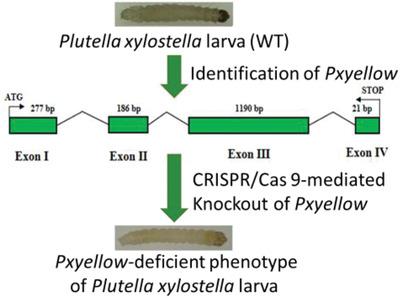当前位置:
X-MOL 学术
›
Insect Sci.
›
论文详情
Our official English website, www.x-mol.net, welcomes your
feedback! (Note: you will need to create a separate account there.)
CRISPR/Cas9-based functional analysis of yellow gene in the diamondback moth, Plutella xylostella
Insect Science ( IF 2.9 ) Pub Date : 2020-09-07 , DOI: 10.1111/1744-7917.12870 Yajun Wang, Yuping Huang, Xuejiao Xu, Zhaoxia Liu, Jianyu Li, Xue Zhan, Guang Yang, Minsheng You, Shijun You
Insect Science ( IF 2.9 ) Pub Date : 2020-09-07 , DOI: 10.1111/1744-7917.12870 Yajun Wang, Yuping Huang, Xuejiao Xu, Zhaoxia Liu, Jianyu Li, Xue Zhan, Guang Yang, Minsheng You, Shijun You

|
The diamondback moth, Plutella xylostella (L.), is an economically important pest of cruciferous crops worldwide. This pest is notorious for rapid evolution of the resistance to different classes of insecticides, making it increasingly difficult to control. Genetics-based control approaches, through manipulation of target genes, have been reported as promising supplements or alternatives to traditional methods of pest management. Here we identified a gene of pigmentation (yellow) in P. xylostella, Pxyellow, which encodes 1674 bp complementary DNA sequence with four exons and three introns. Using the clustered regularly interspersed palindromic repeats (CRISPR)/CRISPR-associated protein 9 system, we knocked out Pxyellow, targeting two sites in Exon III, to generate 272 chimeric mutants (57% of the CRISPR-treated individuals) with color-changed phenotypes of the 1st to 3rd instar larvae, pupae, and adults, indicating that Pxyellow plays an essential role in the body pigmentation of P. xylostella. Fitness analysis revealed no significant difference in the oviposition of adults, the hatchability of eggs, and the weight of pupae between homozygous mutants and wildtypes, suggesting that Pxyellow is not directly involved in regulation of growth, development, or reproduction. This work advances our understanding of the genetic and insect science molecular basis for body pigmentation of P. xylostella, and opens a wide avenue for development of the genetically based pest control techniques using Pxyellow as a screening marker.
中文翻译:

基于 CRISPR/Cas9 的小菜蛾 Plutella xylostella 黄色基因功能分析
小菜蛾Plutella xylostella (L.) 是世界范围内十字花科作物的重要经济害虫。这种害虫因对不同类别杀虫剂的抗性快速进化而臭名昭著,使其越来越难以控制。通过操纵目标基因的基于遗传学的控制方法已被报道为传统害虫管理方法的有希望的补充或替代方法。在这里,我们确定了色素沉着(黄色)的基因小菜蛾,Pxyellow,其编码1674碱基对的互补DNA序列与四个外显子和三个内含。使用成簇的规则散布回文重复序列 (CRISPR)/CRISPR 相关蛋白 9 系统,我们敲除了Pxyellow,针对外显子 III 中的两个位点,产生 272 个嵌合突变体(占 CRISPR 处理个体的 57%),其 1 至 3 龄幼虫、蛹和成虫的颜色发生变化,表明Pxyellow在P. xylostella 的身体色素沉着。适应性分析显示,纯合突变体和野生型之间在成虫的产卵、卵的孵化率和蛹的重量方面没有显着差异,表明Pxyellow不直接参与生长、发育或繁殖的调节。这项工作促进了我们对小菜蛾身体色素沉着的遗传和昆虫科学分子基础的理解,并为开发使用Pxyellow作为筛选标记的基于遗传的害虫控制技术开辟了广阔的道路。
更新日期:2020-09-07
中文翻译:

基于 CRISPR/Cas9 的小菜蛾 Plutella xylostella 黄色基因功能分析
小菜蛾Plutella xylostella (L.) 是世界范围内十字花科作物的重要经济害虫。这种害虫因对不同类别杀虫剂的抗性快速进化而臭名昭著,使其越来越难以控制。通过操纵目标基因的基于遗传学的控制方法已被报道为传统害虫管理方法的有希望的补充或替代方法。在这里,我们确定了色素沉着(黄色)的基因小菜蛾,Pxyellow,其编码1674碱基对的互补DNA序列与四个外显子和三个内含。使用成簇的规则散布回文重复序列 (CRISPR)/CRISPR 相关蛋白 9 系统,我们敲除了Pxyellow,针对外显子 III 中的两个位点,产生 272 个嵌合突变体(占 CRISPR 处理个体的 57%),其 1 至 3 龄幼虫、蛹和成虫的颜色发生变化,表明Pxyellow在P. xylostella 的身体色素沉着。适应性分析显示,纯合突变体和野生型之间在成虫的产卵、卵的孵化率和蛹的重量方面没有显着差异,表明Pxyellow不直接参与生长、发育或繁殖的调节。这项工作促进了我们对小菜蛾身体色素沉着的遗传和昆虫科学分子基础的理解,并为开发使用Pxyellow作为筛选标记的基于遗传的害虫控制技术开辟了广阔的道路。











































 京公网安备 11010802027423号
京公网安备 11010802027423号